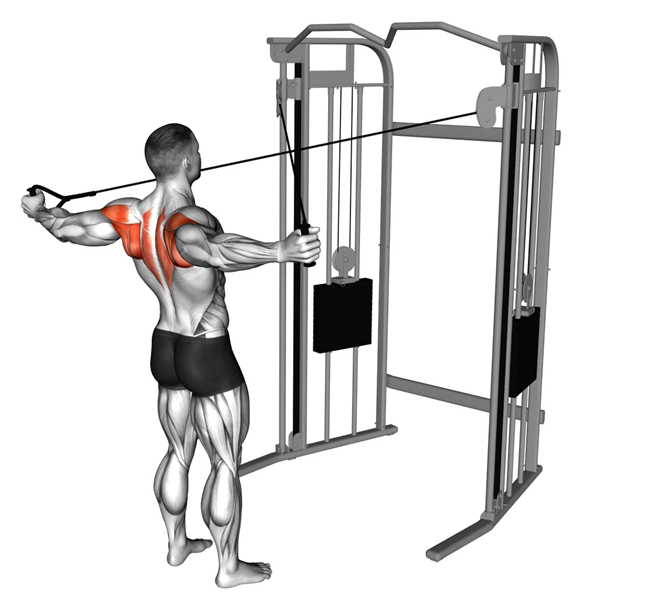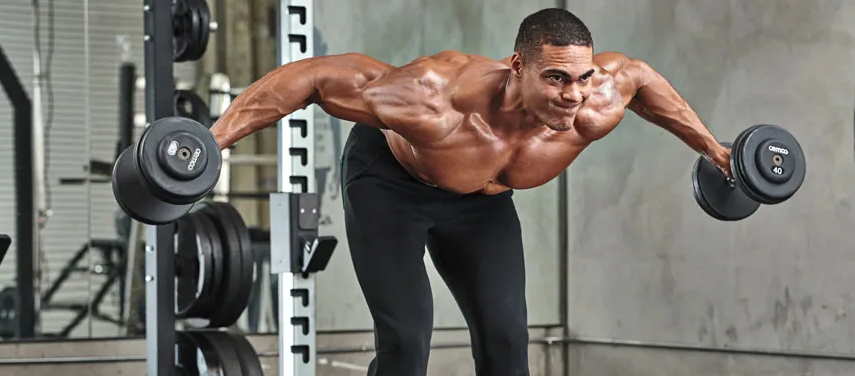Cable Rear Delt Fly: Maximum Rear Delt Growth
When it comes to building 3D, rounded shoulders, most lifters hammer their front and side delts but neglect the rear delts.
The result? Flat-looking shoulders, forward-slumped posture, and physiques that look powerful from the front but unimpressive from behind.
If you want shoulders that look just as dominant from the back as from the front, you need to train your rear delts hard. And while dumbbell rear delt flies are a classic, the Cable Rear Delt Fly takes things up a level by keeping constant tension on the muscles, maximizing the hypertrophy stimulus.
Whether you’re a beginner trying to correct imbalances, or a seasoned bodybuilder chasing that capped, 3D look, the Cable Rear Delt Fly deserves a spot in your routine.
Muscles Worked
The Cable Rear Delt Fly primarily isolates the posterior deltoids but engages surrounding stabilizers for control.
- Primary Muscle:
- Posterior deltoid (rear delt) – responsible for horizontal abduction of the shoulder.
- Secondary Muscles:
- Rhomboids – retract scapula.
- Middle trapezius – stabilize and retract scapula.
- Lower trapezius – assist scapular depression.
- Rotator cuff – stabilize shoulder joint.
- Biceps (minimal) – help stabilize arm position.
👉 Compared to dumbbells, cables keep tension even at the start of the movement, ensuring rear delts never “rest.”
How to Perform the Cable Rear Delt Fly (Step by Step)
Setup
- Set two cables slightly above shoulder height.
- Attach single handles or grab cables directly (no handles) for greater range.
- Stand in the center with arms crossed so your right hand holds the left cable and left hand holds the right cable.
Execution
- Step back slightly and create light tension in cables.
- Start with hands crossed in front of chest, elbows slightly bent.
- Keeping core braced and shoulders down, open arms outward in a wide arc, leading with elbows.
- Pull cables until elbows are in line with shoulders.
- Squeeze rear delts hard at peak contraction.
- Slowly return arms to crossed position, resisting the pull.
Breathing
- Inhale at the start (hands crossed).
- Exhale as you open arms into the fly.
Tempo Recommendation
- Up (concentric): 1–2 seconds.
- Pause: 1 second at peak contraction.
- Down (eccentric): 3 seconds.
Why the Cable Rear Delt Fly Is Superior
- Constant Tension
- Unlike dumbbells, where tension drops at bottom, cables keep rear delts under stress the whole time.
- Customizable Line of Pull
- Adjust cable height for slightly different emphases (low-to-high, high-to-low).
- Joint-Friendly
- Smooth resistance reduces jerky movements and protects shoulder joint.
- Perfect for Hypertrophy
- Controlled tempo and continuous load make it ideal for high-rep pump work.
Common Mistakes and Fixes
- Turning It Into a Row
- Mistake: Pulling hands back instead of out, hitting lats more than delts.
- Fix: Focus on opening arms like wings, not rowing back.
- Shrugging Shoulders
- Mistake: Upper traps dominate.
- Fix: Keep shoulders pulled down and depressed throughout.
- Overbending Elbows
- Mistake: Turning fly into a rear delt row.
- Fix: Keep only a slight bend, elbows leading outward.
- Cutting Range of Motion
- Mistake: Stopping halfway.
- Fix: Pull until elbows are shoulder-level—maximize contraction.
- Using Too Much Weight
- Mistake: Momentum and jerking.
- Fix: Drop weight, increase control.
Variations and Alternatives
- One-Arm Cable Rear Delt Fly
- Perform unilaterally for more focus and symmetry.
- Low-to-High Cable Rear Delt Fly
- Set cables low, pull upward—slightly different angle for muscle fiber emphasis.
- High-to-Low Cable Rear Delt Fly
- Set cables high, pull downward—hits rear delts with more trap engagement.
- Reverse Pec Deck (Machine)
- Fixed path version, beginner-friendly.
- Dumbbell Rear Delt Fly
- Free-weight alternative with simpler setup.
Programming Guidelines
For Strength (Performance Focus)
Rear delts aren’t prime movers for heavy strength, but stronger rear delts = better press stability and scapular health.
- Sets/Reps: 3–4 sets of 8–12 reps.
- Rest: 90 seconds.
- Load: Moderate, controlled.
- Placement: After pulling or pressing work for balance.
For Hypertrophy (Bodybuilding Focus)
This is where cables dominate—high volume, constant tension, and a great pump.
- Sets/Reps: 3–5 sets of 12–20 reps.
- Tempo: Controlled, with a slow eccentric.
- Rest: 45–75 seconds.
- Advanced Methods: Drop sets, partials, supersets with face pulls.
Programming Example (Bodybuilding Shoulders/Back Day)
- Barbell Overhead Press: 4×6
- Upright Rows: 3×10
- Dumbbell Rear Delt Fly: 3×15
- Cable Rear Delt Fly: 4×12–15 (slow squeeze)
- Face Pulls: 3×12
👉 This combination ensures both free weight and constant-tension rear delt work.
Bodybuilder’s Tips
- Use no handles. Grabbing cables directly increases range of motion.
- Keep elbows soft. Too much bend shifts load away from delts.
- Think about spreading cables apart, not pulling back. This keeps rear delts engaged.
- Add a 2-second squeeze at peak. Intensifies contraction and pump.
- Finish with high-rep sets (20+). Great way to chase the pump and hit fibers that don’t get taxed with heavy presses.
Strength vs Aesthetic Outcomes
- Strength-Oriented Lifters: Cable rear delt flies improve scapular stability, helping big lifts like bench, snatch, and jerk by preventing forward shoulder roll.
- Aesthetic-Oriented Lifters: This is where they shine—cables pump the rear delts full of blood, round out shoulders, and carve that 3D look bodybuilders crave.
👉 If dumbbells are your foundation, cables are your finishing weapon for shaping.
Practical Takeaways
- The Cable Rear Delt Fly provides constant tension that dumbbells can’t.
- Perfect for hypertrophy and pump work, especially at higher reps.
- Essential for balancing heavy pressing and preventing shoulder imbalances.
- Works best when paired with dumbbell and machine variations for complete rear delt development.
Conclusion
The Cable Rear Delt Fly is one of the most effective tools for rear delt growth and shoulder balance. By keeping constant tension on the muscle, it solves the biggest problem of dumbbells and lets you chase both growth and stability.
For strength athletes, it keeps shoulders healthy and pressing strong. For bodybuilders, it’s a high-volume hypertrophy machine that builds that sought-after 3D shoulder look.
👉 Bottom line: If you’re serious about your rear delt development, don’t rely on dumbbells alone. Add Cable Rear Delt Flies to your arsenal, control every rep, and watch your shoulders transform.




